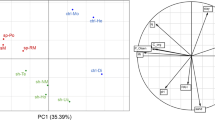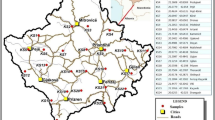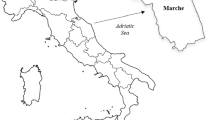Abstract
Background, aim, and scope
The present study examined air pollution effects on soil health applying microbiological parameters. It was carried out near the Angren heavy industry complex in a semiarid region of Uzbekistan. This area was selected in order to establish a national monitoring program for assessing environmental condition of areas remote but downwind from greater emission sources. Moreover, little information exists about how air pollution affects microbiological functioning of soils in semiarid and arid regions of the world, and especially those of Central Asia.
Materials and methods
Soil samples were collected in May 2005 along a 20-km NE–SW river valley transect downwind from the industrial complex. Soil chemical analyses included electrical conductivity, pH, water soluble Na, Ca, and K, total soluble nitrogen, and mineralizable nitrogen content upon a 1:2 digestion by deionized water. Major elements and heavy metal inventory in solids was measured by X-ray fluorescence and atomic absorption spectrometry. Microbiological ecosystem properties were assessed by biological indicators such as basal respiration (R B), microbial biomass related C and N contents, and microbial community functioning coefficients like the metabolic quotient qCO2.
Results
There was a significant spatial dependence and differences for all soil chemical and microbiological parameters tested. The highest contents were found for the relatively volatile metals Zn (≤1,136 mg/kg) and Pb (≤373 mg/kg) in upper soil layers near the power station suggesting that the metal pollutants are derived from local stack emissions. Soil microflora was obviously affected by heavy metals. Significant positive correlations (p ≤ 0.001) were found between the metal content, R B, and qCO2, while a negative one was found for the mineralizable N and C mic/C org ratio. A high total number of nematodes was found only most distant from the industrial emission sources.
Discussion
The results disclosed remarkable spatial dependence not only of the heavy metal impact onto the soil but also of microbiological soil properties in the study area. The latter suggests bioavailability of the anthropogenic metals in the soil affecting the soil microbial community. This is suggested by less biomass formation and higher qCO2 values in heavy metal-contaminated compared to less-polluted soil plots.
Conclusions
Knowledge of these spatial ecosystem functioning patterns and dependence could be very useful in determining and delineating specific land use and management programs that would be suited and feasible for the highly polluted area. Results of this study can be utilized to develop a monitoring program that may quantify harmful effects on the soil health and impact of any future remediation activities.
Recommendations and perspectives
Studies on the relationship between soil biota and pollution levels have raised the question regarding the status of natural soil microbial health, stressing the importance of background data of environmental conditions, and elucidating the importance of this environmental monitoring approach even in semiarid and arid regions. Soil microbiological parameters, in particular the metabolic quotient qCO2 as one of the most sensitive bioindicators identified for that region, should clearly become part of the national environmental monitoring program.



Similar content being viewed by others
References
Alon A, Steinberger Y (1999) Response of the soil microbial biomass and nematode population to a wetting event in nitrogen-amended Negev desert plots. Biol Fertil Soils 30:147–152
Anderson JPE, Domsch KH (1978) Physiological method for quantitative measurement of microbial biomass in soils. Soil Biol Biochem 10:215–221
Anderson TH, Domsch KH (1990) Application of eco-physiological quotients (qCO2 and qD) on microbial biomass from soils of different cropping histories. Soil Biol Biochem 22:251–255
Baath E (1989) Effects of heavy-metals in soil on microbial processes and populations (a review). Water Air Soil Pollut 47:335–379
Bardgett RD, Speir TW, Ross DJ, Yeates GW, Kettles HA (1994) Impact of pasture contamination by copper, chromium, and arsenic timber preservative on soil microbial properties and nematodes. Biol Fertil Soils 18:71–79
Bongers T (1990) The maturity index: an ecological measure of environmental disturbance based on nematode species composition. Oecologia 83:14–19
Brookes PC (1995) The use of microbial parameters in monitoring soil pollution by heavy metals. Biol Fertil Soils 19:269–279
Cairns EJ (1960) Methods in nematology. In: Sasser JN, Jenkins WR (eds) Nematology—fundamentals and recent advances with emphasis on plant parasitic and soil forms. University of North Carolina Press, Chapel Hill, NC, pp 33–84
Chander K, Brookes PC (1991) Effects of heavy-metals from past applications of sewage-sludge on microbial biomass and organic matter accumulation in a sandy loam and silty loam UK soil. Soil Biol Biochem 23:927–932
Doelman P, Jansen E, Michels M, Van TM (1994) Effects of heavy metals in soil on microbial diversity and activity as shown by the sensitivity–resistance index, an ecologically relevant parameter. Biol Fertil Soils 17:177–184
Doran JW, Parkin TB (1996) Quantitative indicators of soil quality: a minimum data set. In: Doran JW, Jones AJ (eds) Methods for assessing soil quality. Soil Sci Soc Am Spec Publ No 49, Madison, WI, pp 25–38
Egamberdiyeva D (2007) The effect of plant growth promoting bacteria on growth and nutrient uptake of maize in two different soils. Appl Soil Ecol 36:184–189
Egamberdiyeva D, Hoflich G (2003) Influence of growth-promoting bacteria on the growth of wheat in different soils and temperatures. Soil Biol Biochem 35:973–978
Giller KE, Witter E, McGrath SP (1998) Toxicity of heavy metals to micro-organisms and microbial processes in agricultural soils: a review. Soil Biol Biochem 30:1389–1414
Gupta VVSR, Yeates GW (1997) Soil microfauna as bioindicators of soil health. In: Pankhurst CE, Doube BM, Gupta VVSR, Grace PR (eds) Soil biota management in sustainable farming systems. CAB Intern, Oxon, UK, pp 201–233
Hattori H (1992) Influence of heavy-metals on soil microbial activities. J Soil Sci Plant Nutr 38:93–100
Heinemayer O, Insam H, Kaiser EA, Walenzik G (1989) Soil microbial biomass and respiration measurements: an automated technique based on infrared gas analysis. Plant Soil 116:191–195
Hofman J, Bezchlebova J, Dusek L, Dolezal L, Holoubek I, Andel P, Ansorgova A, Maly S (2003) Novel approach to monitoring of the soil biological quality. Environ Intern 28:771–778
Houba VJG, Novozamsky I, Vittenbogaard J, Van Der Lee JJ (1987) Automatic determination of total soluble nitrogen in soil extracts. Landw Forsch 40:295–302
Hutchinson TC, Whitby LM (1974) Heavy-metal pollution in the Sudbury mining and smelting region of Canada. I. Soil and vegetation contamination by nickel, copper and other metals. Environmental Conservation 1:123–132
Insam H, Parkinson D, Domsch KH (1989) Influence of macroclimate on soil microbial biomass. Soil Biol Biochem 21:211–221
Insam H, Amor K, Renner M, Crepaz C (1996) Changes in functional abilities of the microbial community during composting of manure. Microb Ecol 31:77–87
Jenkinson DS, Powlson DS (1976) The effects of biocidal treatments on metabolism in soil. V. A method for measuring soil biomass. Soil Biol Biochem 8:209–213
Joergensen RG, Mueller T (1996) The fumigation–extraction method to estimate soil microbial biomass: calibration of the k EN value. Soil Biol Biochem 28:33–37
Kaiser EA, Mueller T, Joergensen RG, Insam H, Heinemeyer O (1992) Evaluation of methods to estimate the soil microbial biomass and the relationship with soil texture and organic matter. Soil Biol Biochem 24:675–683
Kandeler E, Kampichler C, Horak O (1996) Influence of heavy metals on the functional diversity of soil microbial communities. Biol Fertil Soils 23:299–306
Kandeler E, Tscherko D, Spiegel H (1999) Long-term monitoring of microbial biomass, N mineralisation and enzyme activities of a Chernozem under different tillage management. Biol Fertil Soils 28:343–351
Kandeler E, Tscherko D, Bruce KD, Stemmer M, Hobbs PJ, Bardgett RD, Amelung W (2000) Structure and function of the soil microbial community in microhabitats of a heavy metal polluted soil. Biol Fertil Soils 32:390–400
Kelly JJ, Tate RL (1998) Effects of heavy metal contamination and remediation on soil microbial communities in the vicinity of a zinc smelter. J Environ Qual 27:609–617
Kersten M, Förstner U (1995) Speciation of trace metals in sediments and combustion waste. In: Ure A, Ch D (eds) Chemical speciation in natural systems. Chapman & Hall, London, pp 234–275
Klumpp A, Hintemann T, Lima JS, Kandeler E (2003) Bioindication of air pollution effects near a copper smelter in Brazil using mango trees and soil microbiological properties. Environ Pollut 126:313–321
Knight B, McGrath SP, Chaudri AM (1997) Biomass carbon measurements and substrate utilization patterns of microbial populations from soils amended with cadmium, copper, or zinc. Appl Environ Microbiol 63:39–43
Liao M, Xie XM (2007) Effect of heavy metals on substrate utilization pattern, biomass, and activity of microbial communities in a reclaimed mining wasteland of red soil area. Ecotox Environ Safety 66:217–223
Makhmudov MM, Khaitov R (2000) Effective use of steppe pastures and recommendations for raising productivity. ICARDA 26, Tashkent.
McGrath SP, Chaudri AM, Giller KE (1995) Long-term effects of metals in sewage sludges on soils, microorganisms and plants. J Ind Microbiol 14:94–104
Neher DA (2001) Role of nematodes in soil health and their use as indicators. J Nematol 33:161–168
Rowell DL (1994) Soil science: methods and applications. Longmans Group UK, London
Sarig S, Fliessbach A, Steinberger Y (1999) Soil microbial biomass under the canopy of coastal sand dune shrubs. Arid Soil Res Rehab 13:75–80
Sanitation Country Profile (2004) Uzbekistan, http://www.un.org/esa/agenda21/natlinfo/countr/uzbek/sanitatuzb04f.pdf
Shukurov N, Pen-Mouratov S, Steinberger Y (2005) The impact of Almalyk industrial complex on soil chemical and biological properties. Environ Pollut 136:331–340
Sparling GP (1997) Soil microbial biomass, activity and nutrient cycling as indicators of soil health. In: Pankhurst CE, Doube BM, Gupta VVSR (eds) Biological indicators of soil health. CAB International, Wallingford, pp 97–120
Sparling GP, West AW (1990) A comparison of gas chromatography and differential respirometer methods to measure soil respiration and to estimate the soil microbial biomass. Pedobiologia 34:103–112
Sparling GP, Zhu C (1993) Evaluation and calibration of biochemical methods to measure microbial biomass C and N in soils from Western Australia. Soil Biol Biochem 25:1793–1801
Steinberger Y, Sarig S (1993) Responses by soil nematode populations in the soil microbial biomass to a rain episode in the hot, dry Negev Desert. Biol Fertil Soils 16:188–192
Swaine DJ, Goodarzi F (1995) Environmental aspect of trace elements in coal. Kluwer, Dordrecht, p 312
Talipov R, Shukurov N, Tverskaya K (1996) Geochemical study of soils, water and vegetation for estimation of anthropogenic pollution of Chirchik and Akhangaran rivers valleys. Uzbek Geol J 1:44–49
Tate RLIII (2000) Soil microbiology, 2nd edn. Wiley, New York, p 508
UNECE (United Nations Economic Commission for Europe) (2002) Environ Perform Rev Ser 14: Uzbekistan, 196 pp
Valsecchi G, Gugliotti C, Farini A (1995) Microbial biomass, activity, and organic matter accumulation in soils contaminated with heavy metals. Biol Fertil Soils 20:253–259
Vig K, Megharaj M, Sethunathan N, Naidu R (2003) Bioavailability and toxicity of cadmium to microorganisms and their activities in soil: a review. Adv Environ Res 8:121–135
Wardle DA, Ghani A (1995) A critique of the microbial metabolic quotient (qCO2) as a bioindicator of disturbance and ecosystem development. Soil Biol Biochem 27:1601–1610
Wardle DD, Yeates GW, Watson RN, Nicholson KS (1995) The detritus food-web and the diversity of soil fauna as indicators of disturbance regimes in agroecosystems. Plant Soil 170:35–43
Wilcke W, Guscher C, Kobza J, Zech W (1999) Heavy metal concentrations, partitioning, and storage in Slovak forest and arable soils along a deposition gradient. J Plant Nutr Soil Sci 162:223–229
Yao H, Xu J, Huang C (2003) Substrate utilization pattern, biomass and activity of microbial communities in a sequence of heavy metal-polluted paddy soils. Geoderma 115:139–148
Yeates GW, Williams PA (2001) Influence of three invasive weeds and site factors on soil microfauna in New Zealand. Pedobiol 45:367–383
Zhang XK, Li Q, Wang SB, Jiang Y, Liang W (2006) Effect of zinc addition to soil on nematode community structure. Bull Environ Contam Toxicol 76:589–594
Acknowledgements
This project was supported by INTAS and NATO SPS programs as postdoctoral fellowship and reintegration grant to the first author. Mrs. Ginetta Barness, Nora Groschopf, and Antje Friedrichsen provided technical assistance on chemical analyses. We also appreciate the helpful discussions with Prof. Dr. Wolfgang Wilcke and comments by the three anonymous reviewers.
Author information
Authors and Affiliations
Corresponding author
Additional information
Responsible editor: Chengrong Chen
Rights and permissions
About this article
Cite this article
Shukurov, N., Pen-Mouratov, S., Steinberger, Y. et al. Soil biogeochemical properties of Angren industrial area, Uzbekistan. J Soils Sediments 9, 206–215 (2009). https://doi.org/10.1007/s11368-009-0079-8
Received:
Accepted:
Published:
Issue Date:
DOI: https://doi.org/10.1007/s11368-009-0079-8




